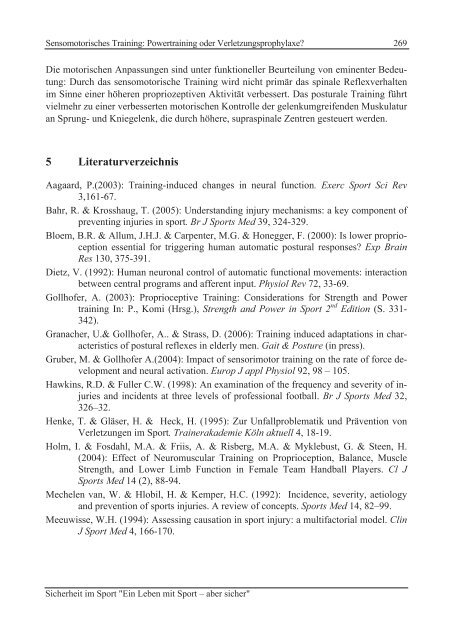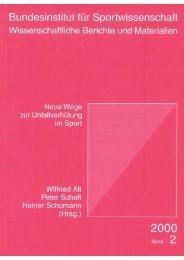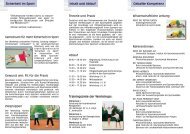- Seite 1:
�����������
- Seite 4 und 5:
Anschrift für die Herausgeber: Dr.
- Seite 6 und 7:
4 Psychologische Aspekte der Sicher
- Seite 8 und 9:
6 Schulsport Inhaltsverzeichnis S.
- Seite 10 und 11:
8 Sicherheit im Sport "Ein Leben mi
- Seite 12 und 13:
10 Vorwort sind, in Zukunft, d.h. b
- Seite 14 und 15:
12 K. Bös Hier wird über eine Koh
- Seite 16 und 17:
14 K. Bös Die Analyse erfolgte mit
- Seite 18 und 19:
16 K. Bös Insgesamt wurden differe
- Seite 20 und 21:
18 Auf der Praxisebene laufen folge
- Seite 22 und 23:
20 K. Bös gleitenden Wissenschafts
- Seite 24 und 25:
22 Forderungen K. Bös 1. Gefordert
- Seite 26 und 27:
24 Sicherheit im Sport "Ein Leben m
- Seite 28 und 29:
26 2 These 2 Die (relative) Unfallg
- Seite 30 und 31:
28 6 These 6 B. Marti Erfolgreiche
- Seite 32 und 33:
30 Sicherheit im Sport "Ein Leben m
- Seite 34 und 35:
32 W. Hollmann Es kommt aber nicht
- Seite 36 und 37:
34 W. Hollmann tur verlangt, um den
- Seite 38 und 39:
36 W. Hollmann körper davon ausgeh
- Seite 40 und 41:
38 W. Hollmann tags durch. Nach die
- Seite 42 und 43:
40 W. Hollmann Auch im Herzmuskel s
- Seite 44 und 45:
42 W. Hollmann älteren und alten M
- Seite 46 und 47:
44 W. Hollmann entscheidende Rolle
- Seite 48 und 49:
46 W. Hollmann 3. Lebensjahrzehnts.
- Seite 50 und 51:
48 W. Hollmann liegen zwischen 8 un
- Seite 52 und 53:
50 W. Hollmann Liesen, H., Dufaux,
- Seite 54 und 55:
52 Sicherheit im Sport "Ein Leben m
- Seite 56 und 57:
54 2 Was bieten Gesundheitsstatisti
- Seite 58 und 59:
56 R. Kisser jährlich Berichte üb
- Seite 60 und 61:
58 Abb. 1: Sportart, die während d
- Seite 62 und 63:
60 R. Kisser aufgesetzt, Träger is
- Seite 64 und 65:
62 R. Kisser Kuratorium für Verkeh
- Seite 66 und 67:
64 2 Beschreiben des Sicherheitsniv
- Seite 68 und 69:
66 Tab. 1: Kriterien für die Bewer
- Seite 70 und 71:
68 O. Brügger der vermiedenen Unfa
- Seite 72 und 73:
70 6 Literatur O. Brügger Allenbac
- Seite 74 und 75:
72 2 Material und Methoden E. Hess-
- Seite 76 und 77:
74 4 Schlussfolgerungen E. Hess-Inf
- Seite 78 und 79:
76 Abb. 1: Arbeitsgebiete, Kernkomp
- Seite 80 und 81:
78 3.2 Präventionsschwerpunkte im
- Seite 82 und 83:
80 Sicherheit im Sport "Ein Leben m
- Seite 84 und 85:
82 R. Meierjürgen Vor diesem Hinte
- Seite 86 und 87:
84 R. Meierjürgen ausgaben infolge
- Seite 88 und 89:
86 N. Moser • Ressourcen ausschö
- Seite 90 und 91:
88 Abb. 1: Kontinuierlicher Verbess
- Seite 92 und 93:
90 N. Moser In den Arbeitshilfen we
- Seite 94 und 95:
92 Sicherheit im Sport "Ein Leben m
- Seite 96 und 97:
94 • Gerätesicherheit • Person
- Seite 98 und 99:
96 C. Müller ebenso oft wird die
- Seite 100 und 101:
98 Sicherheit im Sport "Ein Leben m
- Seite 102 und 103:
100 2.1 Stufe 1 E. Müller Loretz B
- Seite 104 und 105:
102 2.3 Stufe 3 E. Müller Loretz A
- Seite 106 und 107:
104 Sicherheit im Sport "Ein Leben
- Seite 108 und 109:
106 H. Allmer Gefahrenpotentials se
- Seite 110 und 111:
108 H. Allmer lichkeit nicht-kontro
- Seite 112 und 113:
110 H. Allmer nuum mit den Polen So
- Seite 114 und 115:
112 Sicherheit im Sport "Ein Leben
- Seite 116 und 117:
114 2 Methode 2.1 Untersuchungsgrup
- Seite 118 und 119:
116 (2) Angaben zu Verletzungen in
- Seite 120 und 121:
118 A. Steinbacher, J. Kleinert, B.
- Seite 122 und 123:
120 3 Untersuchung S. Jüngling, J.
- Seite 124 und 125:
122 S. Jüngling, J. Kleinert Infor
- Seite 126 und 127:
124 S. Jüngling, J. Kleinert Nitsc
- Seite 128 und 129:
126 1 Modelltheoretische Überlegun
- Seite 130 und 131:
128 J. Kleinert, S. Jüngling, B. S
- Seite 132 und 133:
130 4 Diskussion der Ergebnisse J.
- Seite 134 und 135:
132 Sicherheit im Sport "Ein Leben
- Seite 136 und 137:
134 B. Halberschmidt, M. Tietjens v
- Seite 138 und 139:
136 5 Literatur B. Halberschmidt, M
- Seite 140 und 141:
138 S. Würth Wunsch nach Anerkennu
- Seite 142 und 143:
140 5 Ergebnisse S. Würth Insgesam
- Seite 144 und 145:
142 7 Literaturverzeichnis S. Würt
- Seite 146 und 147:
144 D. Stopper, M. Schwiersch, P. T
- Seite 148 und 149:
146 Prozent 40 30 20 10 0 33,3 26,7
- Seite 150 und 151:
148 0,21 D. Stopper, M. Schwiersch,
- Seite 152 und 153:
150 D. Stopper, M. Schwiersch, P. T
- Seite 154 und 155:
152 K. Wohlgefahrt induzierenden Si
- Seite 156 und 157:
154 Abb. 2: Variable der Risikomind
- Seite 158 und 159:
156 7. Gefahrminderndes Einhalten v
- Seite 160 und 161:
158 4 Literatur K. Wohlgefahrt Anto
- Seite 162 und 163:
160 Sicherheit im Sport "Ein Leben
- Seite 164 und 165:
162 2 Handlungsbedarf eruieren O. B
- Seite 166 und 167:
164 Ereignis danach Physische Konst
- Seite 168 und 169:
166 4 Analyse der Interventionsmög
- Seite 170 und 171:
168 O. Brügger Präventionsarbeite
- Seite 172 und 173:
170 Sicherheit im Sport "Ein Leben
- Seite 174 und 175:
172 S. Niemann, O. Brügger, M. Wal
- Seite 176 und 177:
174 S. Niemann, O. Brügger, M. Wal
- Seite 178 und 179:
176 10% 9% 8% 7% 6% 5% 4% 3% 2% 1%
- Seite 180 und 181:
178 Sicherheit im Sport "Ein Leben
- Seite 182 und 183:
180 R. Kisser Seitens der Sportler
- Seite 184 und 185:
182 R. Kisser reich. Die gegebene I
- Seite 186 und 187:
184 5 Literaturverzeichnis R. Kisse
- Seite 188 und 189:
186 D. Kocholl konsumieren. Die Ris
- Seite 190 und 191:
188 4 Der Charakter der FIS-Regeln
- Seite 192 und 193:
190 D. Kocholl in der ein rascher,
- Seite 194 und 195:
192 D. Kocholl kann, weist König 2
- Seite 196 und 197:
194 D. Kocholl Pistenhalter nicht z
- Seite 198 und 199:
196 D. Kocholl liegt in der weit h
- Seite 200 und 201:
198 M. Walter, O. Brügger • Die
- Seite 202 und 203:
200 • Grundlagen • Material •
- Seite 204 und 205:
202 2 Wie kann das Trampolinturnen
- Seite 206 und 207:
204 3.1 Die Qualifizierung auf Bund
- Seite 208 und 209:
206 3.3 Ausbildung in den Hochschul
- Seite 210 und 211:
208 Sicherheit im Sport "Ein Leben
- Seite 212 und 213:
210 S. Scharenberg qualitativ so zu
- Seite 214 und 215:
212 Angreifen! S. Scharenberg Gerä
- Seite 216 und 217:
214 S. Scharenberg Zum Teil sind di
- Seite 218 und 219:
216 Zielsetzungen S. Scharenberg Da
- Seite 220 und 221: 218 Sicherheit im Sport "Ein Leben
- Seite 222 und 223: 220 L. Thorwesten, S. Schwering, K.
- Seite 224 und 225: 222 L. Thorwesten, S. Schwering, K.
- Seite 226 und 227: 224 3.5 Risikogruppen L. Thorwesten
- Seite 228 und 229: 226 5 Literatur (Auswahl) L. Thorwe
- Seite 230 und 231: 228 2 Methodik P.Wiskamp Zur Gewinn
- Seite 232 und 233: 230 3.4 Anlass der Verletzungen P.W
- Seite 234 und 235: 232 4 Diskussion und Ansätze zur P
- Seite 236 und 237: 234 Sicherheit im Sport "Ein Leben
- Seite 238 und 239: 236 2 Geschlechtsspezifische Aspekt
- Seite 240 und 241: 238 P. Platen Sportlerinnen erklär
- Seite 242 und 243: 240 P. Platen den genannten Symptom
- Seite 244 und 245: 242 P. Platen Insgesamt scheint als
- Seite 246 und 247: 244 P. Platen Empfehlungen zur Einn
- Seite 248 und 249: 246 P. Platen Hewett, T.E., Stroupe
- Seite 250 und 251: 248 Sicherheit im Sport "Ein Leben
- Seite 252 und 253: 250 T. Henke, D. Schulz, P. Platen
- Seite 254 und 255: 252 T. Henke, D. Schulz, P. Platen
- Seite 256 und 257: 254 T. Henke, D. Schulz, P. Platen
- Seite 258 und 259: 256 T. Henke, D. Schulz, P. Platen
- Seite 260 und 261: 258 T. Henke, D. Schulz, P. Platen
- Seite 262 und 263: 260 T. Henke, D. Schulz, P. Platen
- Seite 264 und 265: 262 T. Henke, D. Schulz, P. Platen
- Seite 266 und 267: 264 A. Gollhofer eine statistisch g
- Seite 268 und 269: 266 A. Gollhofer Auf der Basis des
- Seite 272 und 273: 270 A. Gollhofer Myklebust, G. & En
- Seite 274 und 275: 272 W. Alt, S. Brand Bezug auf spor
- Seite 276 und 277: 274 W. Alt, S. Brand passiven Beweg
- Seite 278 und 279: 276 W. Alt, S. Brand Gruber, M. (20
- Seite 280 und 281: 278 Sicherheit im Sport "Ein Leben
- Seite 282 und 283: 280 2 Methodik E. Eils, R. Schröte
- Seite 284 und 285: 282 Tab. 2: E. Eils, R. Schröter,
- Seite 286 und 287: 284 E. Eils, R. Schröter, D. Rosen
- Seite 288 und 289: 286 Sicherheit im Sport "Ein Leben
- Seite 290 und 291: 288 Anzahl: prozentualer Anteil (be
- Seite 292 und 293: 290 K. Mosetter Lig. transverseum a
- Seite 294 und 295: 292 K. Mosetter Eine weitere Konver
- Seite 296 und 297: 294 4 Das Therapiekonzept der Myore
- Seite 298 und 299: 296 Sicherheit im Sport "Ein Leben
- Seite 300 und 301: 298 V. Senner die Probanden der Ver
- Seite 302 und 303: 300 V. Senner tung zu insgesamt wen
- Seite 304 und 305: 302 V. Senner Da in der Literatur k
- Seite 306 und 307: 304 V. Senner Abb. 5: Simulierte Fl
- Seite 308 und 309: 306 V. Senner konstruiert. Abb. 8 z
- Seite 310 und 311: 308 V. Senner door-Bereich gesenkt
- Seite 312 und 313: 310 Sicherheit im Sport "Ein Leben
- Seite 314 und 315: 312 J. Bosak, C. Weingärtner 1. Wi
- Seite 316 und 317: 314 3 Ergebnisse 3.1 Analyse J. Bos
- Seite 318 und 319: 316 3.3 Durchsetzung und Verantwort
- Seite 320 und 321:
318 Gefährdungs- Zielformulierung
- Seite 322 und 323:
320 3 Europäische Richtlinie zu PS
- Seite 324 und 325:
322 H.-H. Lehnecke recht um Sachmä
- Seite 326 und 327:
324 H.-H. Lehnecke besondere die Sp
- Seite 328 und 329:
326 H. Semsch Hierzu werden einige
- Seite 330 und 331:
328 H. Semsch Abb. 4: Nur eine gut
- Seite 332 und 333:
330 Sicherheit im Sport "Ein Leben
- Seite 334 und 335:
332 M. Walter, O. Brügger Auf Grun
- Seite 336 und 337:
334 Abb. 2: Dorsale Krümmung des H
- Seite 338 und 339:
336 M. Walter, O. Brügger schuhe e
- Seite 340 und 341:
338 2 Sicherheitsbedürfnisse der N
- Seite 342 und 343:
340 G. Weber, H. Ziegler, P. Schaff
- Seite 344 und 345:
342 G. Weber, H. Ziegler, P. Schaff
- Seite 346 und 347:
344 Sicherheit im Sport "Ein Leben
- Seite 348 und 349:
346 2 Schulsportunfälle S. Dieteri
- Seite 350 und 351:
348 S. Dieterich dass mangelnde spo
- Seite 352 und 353:
350 S. Dieterich Abb. 4: Verteilung
- Seite 354 und 355:
352 S. Dieterich Tab. 1: Determinat
- Seite 356 und 357:
354 S. Dieterich gehen, dass die ef
- Seite 358 und 359:
356 G. Schnabel tigkeiten und Fähi
- Seite 360 und 361:
358 G. Schnabel schätzung der eige
- Seite 362 und 363:
360 G. Schnabel Bei der Risikoeinsc
- Seite 364 und 365:
362 Sicherheit im Sport "Ein Leben
- Seite 366 und 367:
364 H. Feuß kompetenz) findet sich
- Seite 368 und 369:
366 H. Feuß Daher ist Sicherheitsf
- Seite 370 und 371:
368 Sicherheit im Sport "Ein Leben
- Seite 372 und 373:
370 I. Schlesinger dem Ost- und dem
- Seite 374 und 375:
372 I. Schlesinger ler. Ein weitere
- Seite 376 und 377:
374 5 Literatur I. Schlesinger Bund
- Seite 378 und 379:
376 D. Schnell • Etwa 2/3 der Ver
- Seite 380 und 381:
378 3.2 Gefährdung der Augen im Sc
- Seite 382 und 383:
380 D. Schnell Die häufigsten Verl
- Seite 384 und 385:
382 D. Schnell Abb. 3: Sport-gerech
- Seite 386 und 387:
384 Sicherheit im Sport "Ein Leben
- Seite 388 und 389:
386 M. Pfitzner 2 Welche Folgerunge
- Seite 390 und 391:
388 Handballspiel sollen ein mögli
- Seite 392 und 393:
390 M. Pfitzner müssen so eben noc
- Seite 394 und 395:
392 Sicherheit im Sport "Ein Leben
- Seite 396 und 397:
394 2 Die rechtliche Relevanz der K
- Seite 398 und 399:
396 D. Kocholl Britschgi 9 gilt bei
- Seite 400 und 401:
398 D. Kocholl vorgenommen werden.
- Seite 402 und 403:
400 D. Kocholl Ausnahme bilden. Die
- Seite 404 und 405:
402 Vereinssport Nicht org. Sport S
- Seite 406 und 407:
404 H.-F. Voigt, M. Dahlinger Auch
- Seite 408 und 409:
406 - Symbiose koordinativer Fähig
- Seite 410 und 411:
408 Abb. 10: Bereich „Kraft“: K
- Seite 412 und 413:
410 Sicherheit im Sport "Ein Leben
- Seite 414 und 415:
412 P. Stehle, T. Schumacher 3 Zeit
- Seite 416 und 417:
414 Übungen mit Ball / ohne Ball S
- Seite 418 und 419:
416 P. Stehle, T. Schumacher fachen
- Seite 420 und 421:
418 Sicherheit im Sport "Ein Leben
- Seite 422 und 423:
420 Tab. 1: Beim Vorwärtsfallen is
- Seite 424 und 425:
422 Sicherheit im Sport "Ein Leben
- Seite 426 und 427:
424 M. Buchser 4. Wie oft und inten
- Seite 428 und 429:
426 Sicherheit im Sport "Ein Leben
- Seite 430 und 431:
428 K. Oltmanns rungen adäquat umz
- Seite 432 und 433:
430 K. Oltmanns runde stehen (Gefah
- Seite 434 und 435:
432 Sicherheit im Sport "Ein Leben
- Seite 436 und 437:
434 T. Bach Land als BGS-Kräfte er
- Seite 438 und 439:
436 Abb. 1. . Hot Spotting Hot spot
- Seite 440 und 441:
438 Sicherheit im Sport "Ein Leben
- Seite 442 und 443:
440 2 Hauptergebnisse 2.1 Häufigke
- Seite 444 und 445:
442 M. Baumgartner, G. Furian pe/Pe
- Seite 446 und 447:
444 2.10 Gründe für die Wahl des
- Seite 448 und 449:
446 K. Engelhard, J. Kleinert auf d
- Seite 450 und 451:
448 K. Engelhard, J. Kleinert nehme
- Seite 452 und 453:
450 K. Engelhard, J. Kleinert stän
- Seite 454 und 455:
452 G. Jendrusch, L. Kaczmarek, P.
- Seite 456 und 457:
454 G. Jendrusch, L. Kaczmarek, P.
- Seite 458 und 459:
456 G. Jendrusch, L. Kaczmarek, P.
- Seite 460 und 461:
458 2.4 Fazit / Schlussfolgerungen
- Seite 462 und 463:
460 Sicherheit im Sport "Ein Leben
- Seite 464 und 465:
462 J. Ries Die Qualität und Quant
- Seite 466 und 467:
464 J. Ries oder die Delegation der
- Seite 468 und 469:
466 J. Ries cherheit im Hochschulsp
- Seite 470 und 471:
468 J. Schröder, K.-M. Braumann, K
- Seite 472 und 473:
470 70 60 50 40 30 20 10 0 J. Schr
- Seite 474 und 475:
472 5 Literaturverzeichnis J. Schr
- Seite 476 und 477:
474 J. Schröder, S. Patra, R. Reer
- Seite 478 und 479:
476 J. Schröder, S. Patra, R. Reer
- Seite 480 und 481:
478 Sicherheit im Sport "Ein Leben
- Seite 482 und 483:
480 P. Spitzer, G. Schimpl Bezogen
- Seite 484 und 485:
482 Injury Ratio 2 1,5 1 0,5 0 Stei
- Seite 486 und 487:
484 Sicherheit im Sport "Ein Leben
- Seite 488 und 489:
486 M. Walter Wildtieren. Lawinenku
- Seite 490 und 491:
488 M. Walter Abb. 4: Die Definitio
- Seite 492 und 493:
490 • Sonnenschutz • Karte des
- Seite 494 und 495:
492 Katharina Engelhardt Deutsche S
- Seite 496 und 497:
494 Edith Müller-Loretz Schweizeri
- Seite 498:
496 Gunther Weber TÜV SÜD Life Se




